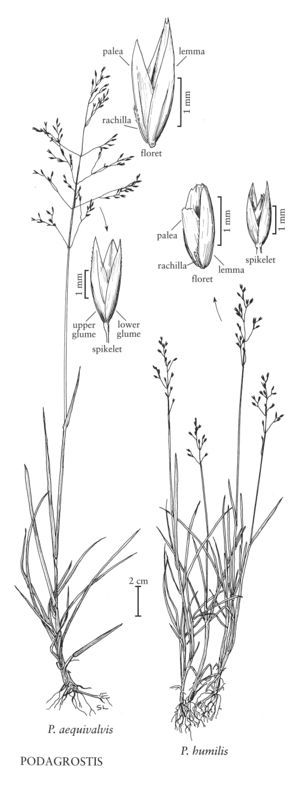Podagrostis aequivalvis
Plants rhizomatous. Culms 25-90 cm, erect; nodes 2-4(6). Sheaths smooth; ligules 0.4-4 mm, scabridulous, truncate to subacute, entire or lacerate; blades 4-18 cm long, 1-2.5 mm wide, flat. Panicles 5-15 cm long, 2-10 cm wide, lanceolate to ovate, often drooping, sparsely branched, lowest nodes with 1-4(5) branches; branches usually scabridulous, sometimes smooth, erect to ascending or spreading, spikelets usually restricted to the distal 1/2; lower branches 3-6 cm; pedicels 2-10 mm. Spikelets narrowly ovate to lanceolate, usually purplish bronze, sometimes greenish purple; rachilla prolongations 0.5-1.9 mm, bristlelike, distal hairs shorter than 0.3 mm. Glumes 2.3-4.3 mm, veins sparsely scabridulous distally, apices acute to acuminate, sometimes apiculate; lower glumes usually equal to the upper glumes, usually 3-veined, lateral veins faint; calluses glabrous or with sparse hairs shorter than 0.1 mm; lemmas 2.5-3.5 mm, smooth, opaque, (3)5-veined, veins usually obscure, apices acute, entire or the veins minutely excurrent to about 0.3 mm, unawned; paleas 2-3 mm; anthers 3, 0.8-1.3 mm. Caryopses 1.2-1.5 mm; endosperm solid. 2n = 14.
Discussion
Podagrostis aequivalvis grows along lake, bog, and stream margins, and in forest fens. It is common in the coastal regions of Alaska and British Columbia, and occurs less frequently inland, as well as to about 1500 m in the Cascade Mountains south to Oregon.
Selected References
None.
